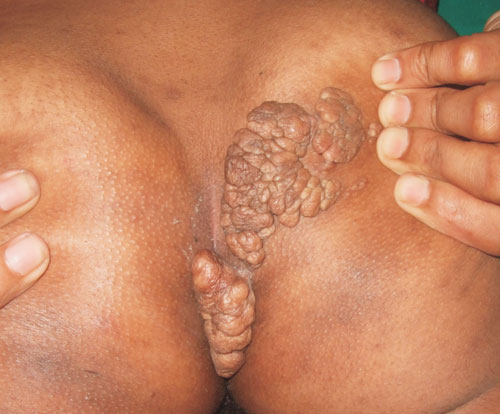|
|
|
Indian Pediatr 2015;52: 265-266 |
 |
Nevus Lipomatosus Cutaneous Superficialis
|
|
*Rajesh Kumar Mandal, Abhijit Dutta and
#Sudip Kumar Ghosh
Departments of *Dermatology and
Pediatric Medicine, North Bengal Medical College
and #Dermatology, RG Kar Medical College;
Kolkata, West Bengal, India.
Email:
[email protected]
|
A 16-year-old girl presented with a few slow-growing
asymptomatic swellings on her buttocks since 8 years of age.
Examination showed skin-colored, fleshy, non-tender,
partially compressible, firm, protuberant mass with a
cerebriform surface, located over the right gluteal area
extending to the natal cleft (Fig. 1).
Systemic examination and routine laboratory evaluation was
normal. Histopathological examination showed clusters of
mature adipocytes arranged in the mid and upper dermis
around blood vessels and eccrine glands, along with
hyperkeratosis and acanthosis of the overlying epidermis. A
diagnosis of classic type of nevus lipomatosis cutaneous
superficialis was made.
 |
|
Fig. 1 Multiple skin-colored,
fleshy, protuberant mass with a cerebriform surface.
|
Nevus lipomatosis cutaneous superficialis
(NLCS) is a rare hamartoma of adipose tissue presenting as
multiple, soft, skin-coloured or yellowish lobules that may
coalesce to give rise to the distinctive cerebriform
surface. The lesions may present at birth or develop in the
first two decades of life. Lower back, hip, upper thigh and
abdomen are the commonly affected sites. The common
differential diagnoses in the present case were: plexiform
neurofibromatosis (folded overlying skin and
hyper-pigmentation), verrucous epidermal nevus (dirty gray
or dark brown coalescing papules with a verrucous surface),
superficial lymphatic malformation (grouped, tense vesicular
lesions with clear colourless fluid). Since NLCS is usually
asymptomatic, treatment is required only for the cosmetic
reasons. Excision is usually curative and recurrences after
surgery are uncommon.
|
|
|
 |
|

